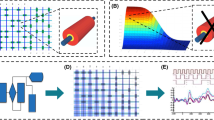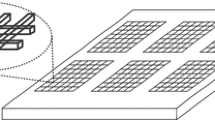Abstract
We propose a built-in self-test (BIST) procedure for nanofabrics implemented using chemically assembled electronic nanotechnology. Several fault detection configurations are presented to target stuck-at faults, shorts, opens, and connection faults in nanoblocks and switchblocks. The detectability of multiple faults in blocks within the nanofabric is also considered. We present an adaptive recovery procedure through which we can identify defect-free nanoblocks and switchblocks in the nanofabric-under-test. The proposed BIST, recovery, and defect tolerance procedures are based on the reconfiguration of the nanofabric to achieve complete fault coverage for different types of faults. We show that a large fraction of defect-free blocks can be recovered using a small number of BIST configurations. We also present simple bounds on the recovery that can be achieved for a given defect density. Simulation results are presented for various nanofabric sizes, different defect densities, and for random and clustered defects. The proposed BIST procedure is well suited for regular and dense architectures that have high defect densities.
Similar content being viewed by others
References
M. Abramovici, E. Lee, and C. Stroud, “BIST-based Diagnostics for FPGA Logic Blocks,” Proc.—International Test Conference, 1997, pp. 539–547.
J.G. Brown and R.D.S. Blanton, “CAEN–BIST: Testing the Nanofabric,” Proc.—International Test Conference, 2004, pp. 462–471.
M. Butts, A. DeHon, and S.C. Goldstein, “Molecular Electronics: Devices, Systems and Tools for Gigagate, Gigabit Chips,” Proc. International Conference on Computer-aided Design, 2002, pp. 433–440.
Y. Chen, G.-Y. Jung, D.A.A. Ohlberg, X. Li, D.R. Stewart, J.O. Jeppesen, K.A. Nielsen, J.F. Stoddart, and R. StanleyWilliams, “Nanoscale Molecular-switch Crossbar Circuits,” Nanotechnology, vol. 14, pp. 462–468, Mar. 2003.
W.B. Culbertson, R. Amerson, R.J. Carter, P. Kuekes, and G. Snider, “Defect Tolerance on the Teramac Custom Computer,” Proc. IEEE Symposium on Field-programmable Custom Computing Machines, 1997, pp. 116–223.
S.C. Goldstein and M. Budiu, “NanoFabrics: Spatial Computing Using Molecular Electronics,” Proc.—International Symposium on Computer Architecture, 2001, pp. 178–189.
S.C. Goldstein and D. Rosewater, “Digital Logic Using Molecular Electronics,” Proc. IEEE International Solid State Circuits Conference, vol. 1, pp. 204–459, 2002.
S.C. Goldstein and D. Rosewater, What Makes a Good Molecular-scale Computer Device? School of Computer Science, Carnegie Mellon University, Tech. Rep. CMU-CS-02-181, Sep. 2002.
J.R. Heath, P.J. Kuekes, G.S. Snider, and R.S. Williams, “A Defect-tolerant Computer Architecture: Opportunities for Nanotechnology,” Science, vol. 280, pp. 1716–1721, Jun. 1998.
A. Mabrouk and A. Hubbard, “Design and Implementation of an Optical Testing Technique for VLSI Chips Using a Potential-sensitive Fluorescing Dye,” Proc. IEEE Pacific Rim Conference on Communications, Computers and Signal Processing, 1997, pp. 568–572.
C. Metra, G. Mojoli, S. Pastore, D. Salvi, and G. Sechi, “Novel Technique for Testing FPGAs,” Proc. Design, Automation and Test in Europe, 1998, pp. 89–94.
M. Mishra and S. Goldstein, “Defect Tolerance at the End of the Roadmap,” Proc. International Test Conference, 2003, pp. 1201–1210.
Nantero Inc., http://nantero.com/.
E.J. Nowack, “Maintaining the Benefits of CMOS Scaling When Scaling Bogs Down,” IBM J. Res. Develop., no. 2/3, March/May 2002.
R.M. Rad and M. Tehranipoor, “SCT: An Approach for Testing and Configuring Nanoscale Devices,” Proc. IEEE VLSI Test Symposium, 2006, pp. 370–377.
S. Sayil, “All-silicon Optical Contactless Testing of ICs,” Int. J. Electron., vol. 89, pp. 537–547, 2002.
S. Sayil, D.V. Kerns, and S.E. Kerns, “A Survey Contactless Measurement and Testing Techniques,” IEEE Potentials, vol. 24, pp. 25–28, Feb–Mar 2005.
M.R. Stan, P.D. Franzon, S.C. Goldstein, J.C. Lach, and M.M. Ziegler, “Molecular Electronics: From Devices and Interconnect to Circuits and Architecture,” Proc. IEEE, vol. 91, pp. 1940–1957, Nov. 2003.
C. Stroud, S. Konala, P. Chen, and M. Abramovici, “Built-in Self-test of Logic Blocks in FPGAs (Finally, a Free Lunch: BIST without Overhead!),” Proc. IEEE VLSI Test Symposium, 1996, pp. 387–392.
M. Tahoori and S. Mitra, “Techniques and Algorithms for Fault Grading of FPGA Interconnect Test Configurations,” IEEE Trans. Comput.-aided Des. Integr. Circuits Syst., vol. 23, pp. 261–272, Feb. 2004.
M.B. Tahoori, E.J. McCluskey, M. Renovell, and P. Faure, “A Multi-configuration Strategy for an Application Dependent Testing of FPGAs,” Proc. IEEE VLSI Test Symposium, 2004, pp. 154–159.
M. Tehranipoor, “Defect Tolerance for Molecular Electronics-based NanoFabrics Using built-In Self-test Procedure,” Proc. International Symposium on Defect and Fault Tolerance in VLSI Systems, 2005, pp. 305–313.
A.J. van de Goor, Testing Semiconductor Memories: Theory and Practice. ComTex, 1998.
M. Vallet and P. Sardin, “Electrical Testing for Failure Analysis: Ebeam Testing,” Microelectron. Eng., vol. 49, pp. 157–167, 1999.
S.J. Wang and T.M. Tsai, “Test and Diagnosis of Fault Logic Blocks in FPGAs,” IEE Proc. Comp. Digit. Tech., vol. 146, pp. 100–106, 1999.
Z. Wang and K. Chakrabarty, “Built-in Self-test of Molecular Electronics-based Nanofabrics,” Proc. European Test Symposium, 2005, pp. 168–173.
Author information
Authors and Affiliations
Corresponding author
Additional information
Editor: M. Tehranipoor
A preliminary version of this paper was published in Proceeding of the IEEE International Test Conference, 2005.
Rights and permissions
About this article
Cite this article
Wang, Z., Chakrabarty, K. Built-in Self-test and Defect Tolerance in Molecular Electronics-based Nanofabrics. J Electron Test 23, 145–161 (2007). https://doi.org/10.1007/s10836-006-0550-z
Received:
Revised:
Published:
Issue Date:
DOI: https://doi.org/10.1007/s10836-006-0550-z




